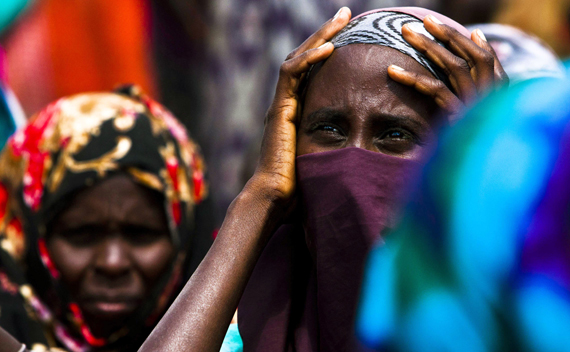Catastrophe in the Horn: Causes and Responses
More on:

The area straddling Somalia, Ethiopia and northern Kenya, has been dubbed the “triangle of death” as the worst drought in more than fifty years grips the area. An estimated thirty percent of children are malnourished, many arriving in refugee camps so “emaciated and with skin lesions so deep that you could see their bones showing in their skulls and arms.” According to testimony by State Department official Reuben Brigety, acute malnutrition has reached 50% and 40%, respectively, in Ethiopia and Kenya—far above the 15% threshold for an international humanitarian emergency.
The causes of this emergency are complex, and the international effort to address the situation is well-intentioned, but the crisis demands a broader and dramatic reaction, which sadly, remains improbable.
Somalis have not been governed by a central government since 1991, which has aggravated a number of the famine’s contributing factors beyond the oft-cited violent conflict and drought. Over the last year, fuel and food price increases have surpassed 300 percent in the Somali capital. Regional deforestation has devastated traditional ecosystems, eliminating trees, grazing land, and water and rendering the tri-nation area “more or less dry.” Much of the productive farmland has been leased to China, Saudi Arabia, and India, so desperately needed food has been exported to foreign markets. Finally, local farmers lack machinery and fertilizer, leading to low agricultural outputs and the absence of food reserves to sustain people during droughts or other shocks.
On Monday, the U.N. World Food Program (WFP) announced a plan to airlift food aid into Somalia, and the United Nations has raised $1 billion to address the issue. While this may temporarily stem the number of deaths, it is unlikely to address the economic and climatological forces underlying the disaster.
Furthermore, foreign food aid itself—while life-saving—risks exacerbating the underlying problem.
As my colleague Laurie Garrett explained in 2009,
“79 percent of all food aid last year from wealthy countries was delivered in the form of domestically produced surplus crops, shipped via rich-country transport mechanisms...Upwards of 40 percent of all food aid spending last year was eaten up by shipping and distribution costs… Hundreds of foreign aid organizations—in the UN system, bilateral government programs, and NGOs—have tried for decades to improve agricultural production inside poor countries… Shipping food, grown by subsidized farmers toiling inside rich countries, distorts local markets not only inside famine-affected countries, but across entire regions…The longer-term impact of donated food, then, is to destroy all positive market incentives for local farmers.”
Speaking before the U.S. House Committee on Agriculture, Nancy Lindborg, the assistant administrator for democracy, conflict, and humanitarian assistance of the U.S. Agency for International Development (USAID) echoed these concerns. She described how the “multiple legislative mandates” tied to U.S. food aid “create a number of operational difficulties and hinder the effectiveness.” For instance, 75 percent of aid commodities must be “processed, fortified or bagged,” forcing USAID to “make less than optimal product selections.”
Counterterrorist concerns have also complicated and slowed the U.S. response. In recent years the United States has cut humanitarian aid to Somalia, on the grounds that that al-Shabaab, the militant Islamist group that controls much of the south, will divert assistance to its own profit. For its part, Al Shabaab denies that Somalia is suffering from a famine and continues to prohibit UNICEF and WFP from operating in the country. Despite earlier promises of access, it now declares that only the Red Cross and Red Crescent Societies may remain.
The upshot? “More than 3.5 million Somalis, the vast majority of them in the insurgent-held areas, may starve to death,” according to Somali Foreign Minister Mohamed Ibrahim.
Can anything be done to improve humanitarian access? Joel Charny of InterAction, an alliance of U.S. relief organizations, thinks so, but only if the United States shows greater flexibility. He emphasizes that U.S. sanctions and legal issues unnecessarily complicate the delivery of aid:
“Al-Shabaab has made life very difficult for our [humanitarian aid] community in South Central [Somalia], but it’s not across the board and it’s something that we can negotiate on a case-by-case basis…. The approach of the U.S. government, up to now, has been so absolutist. They’re basically saying that the diversion of almost, literally, a cup of rice constitutes grounds to more of less shut down an entire aid program for hundreds of thousands of vulnerable people.”
Even if aid organizations could penetrate the areas held by al-Shabaab, food aid alone will not eliminate the underlying causes of the crisis mentioned above. Barring the construction of a well-functioning state by internal forces—which sadly appears unlikely given the past twenty years—addressing the underlying causes would require long-term strategy from the international community. The 9,200-strong African Union peacekeeping force currently restricted to Mogadishu will not be able to provide political stability, and UN member states, including the United States show little appetite for a robust mission in the region. Still, the international community has the power to tailor food aid that doesn’t disrupt local economies and increases agricultural productivity so farmers can save surpluses, through support for technological improvement like irrigation systems.
More on:
 Online Store
Online Store
